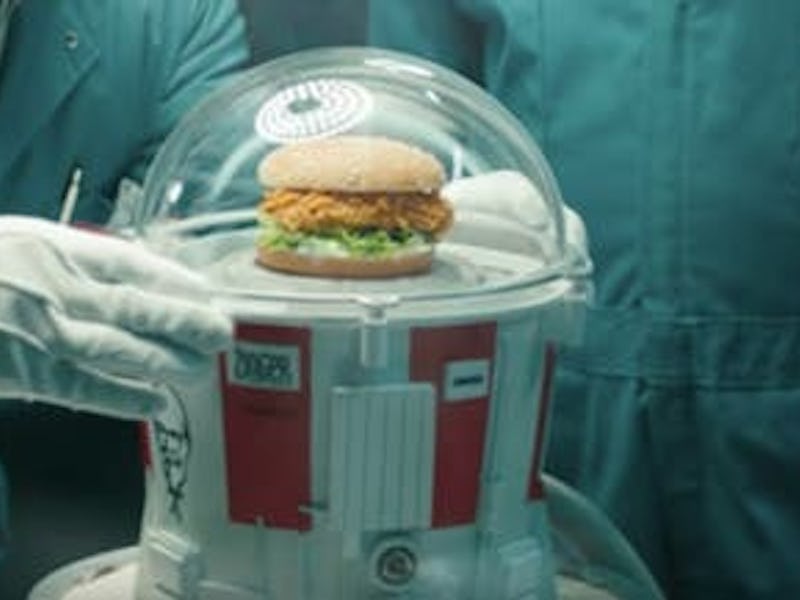A chicken sandwich is going where no chicken sandwich has never been before: the edge of space. Kentucky Fried Chicken’s Zinger sandwich made its space travel debut early Thursday morning when it was launched into the stratosphere in a high-altitude World View Stratollite balloon, carrying a specially designed bucket meant to keep the precious spacefaring Zinger safe. But will the sandwich be safe enough to eat when it parachutes back to Earth in four days?
In the promotional video for the historic space flight, Rob Lowe, dressed as Mission Commander Colonel Sanders, confidently said we “will lick our fingers good” if KFC succeeds. But it won’t be after eating the space sandwich, the bucket’s creators admitted to Inverse. Here’s why.
When the MediaMonks Chicken Bucket Payload Team (yes, that’s its actual name) was commissioned by World View to make a bucket to protect the Zinger when it’s 31 miles in the air, they were up against two major obstacles: extreme cold and extreme radiation.
While you might think refrigeration would preserve the sandwich, it certainly won’t at the frigid temperatures of the stratosphere. Astrophysicist and Boston University professor John Clarke, Ph.D., tells Inverse that 35,000 to 180,000 feet off the ground, the temperature can be as low as -80 degrees Fahrenheit, and the air there is much thinner. To compensate for this, the Chicken Bucket Payload Team carefully insulated the bucket to keep the chicken and the electronics of the bucket working properly. It’s also temperature controlled to keep the sandwich at a moderate 70 degrees Fahrenheit for the entire trip. While the bucket has a thermostat on board, it also has sensors that can send information about the sandwich’s environment to Mission Control in case the researchers can make adjustments via the bucket’s heating elements.
The radiation poses a bigger issue — one whose effects on a sandwich we aren’t quite sure about because we’ve never sent a sandwich to space. Clarke explains that there is more solar UV radiation and cosmic radiation at that altitude, both of which are harmful in different ways. The Chicken Bucket Payload Team didn’t take any chances; they insulated the sandwich with aluminized mylar, the same material used in NASA space suits and shuttles, to block out both UV and cosmic radiation.
The KFC Zinger chicken sandwich will be housed in the high tech bucket for four days.
With all these protective components in place, you would think the sandwich would be safe to eat upon its return, but one final, somewhat disappointing element ensures nobody will take a bite. According to the Chicken Bucket Payload Team, the chicken and the sesame bun in the sandwich have been treated with polyurethane to keep it looking tasty for the five on-board cameras, which will live-stream its descent when it comes down to Earth at 2,000 feet per minute, hopefully, on Monday, July 3.
Ultimately, said Rafael Fittipaldi, the creative technical director at MediaMonks, in an interview with Inverse, it’s the polyurethane in the sandwich that’s the biggest appetite killer. But the constant temperature and the near-vacuum condition in the bucket, he insists, maintains the sandwich’s integrity, and the sandwich would be completely edible and delicious if it weren’t treated with chemicals.
“During our tests on the vacuum chamber we left the burger there for four days and had a fellow colleague that took a bite and swears it was still tasty!” said Fittipaldi.
